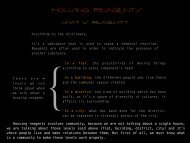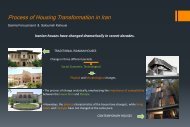Housing Concepts - Oikodomos
Housing Concepts - Oikodomos
Housing Concepts - Oikodomos
Create successful ePaper yourself
Turn your PDF publications into a flip-book with our unique Google optimized e-Paper software.
OIKODOMOS <strong>Housing</strong> <strong>Concepts</strong><br />
PROXIMITY<br />
Proximity: The state, quality, sense or fact of being near or next; closeness.<br />
Proximity is clearly about distance, but we should not simply define a distance as<br />
the length between two points. Its meaning should widen and define proximity as a<br />
mix of social, territorial, symbolic and physical aspects. For example, one can<br />
utilize the physical proximity while experiencing a set of important social<br />
boundaries. This is exemplified in a housing block where one lives close to<br />
neighbours but have no real social relationship. The opposite situation can occur<br />
as well: living in a house with a surrounding garden and having a real intense<br />
relationship with one’s neighbours. Likewise, we can notice the difference between<br />
rural or more urbanised areas that affect the model of proximity: density,<br />
functional mix, accessibility and the way of defining limits affects the reading of<br />
relative distances.<br />
In other words, proximity does not refer to absolute values but is a relative<br />
issue, lately in an increasing way. New technologies define new models of<br />
proximity, thereby configuring relationships based on car traffic or public<br />
transport, wireless technologies, eliminating distances. On the macro scale, air<br />
traffic also changes the way we inhabit the contemporary landscape.<br />
Urban planners can design physical borders and know how we can create or destroy<br />
them, but they cannot control all the defining social factors.<br />
In an urban context,<br />
proximity is defined by<br />
the relationship to<br />
accessing and moving in<br />
the interdependence<br />
between two points. ”Hutongs”<br />
in Beijing are<br />
based on sets of<br />
repetitive relative<br />
distances with social<br />
meaning. The recent<br />
changes in the urban<br />
configuration on a larger<br />
scale have produced new<br />
boundaries within the<br />
city, interrupting the<br />
inhabitants’ initial<br />
understanding and<br />
intuition of proximity.<br />
The change is not only<br />
visual or physical but<br />
also has consequences in<br />
the social behavior of<br />
its inhabitants.






